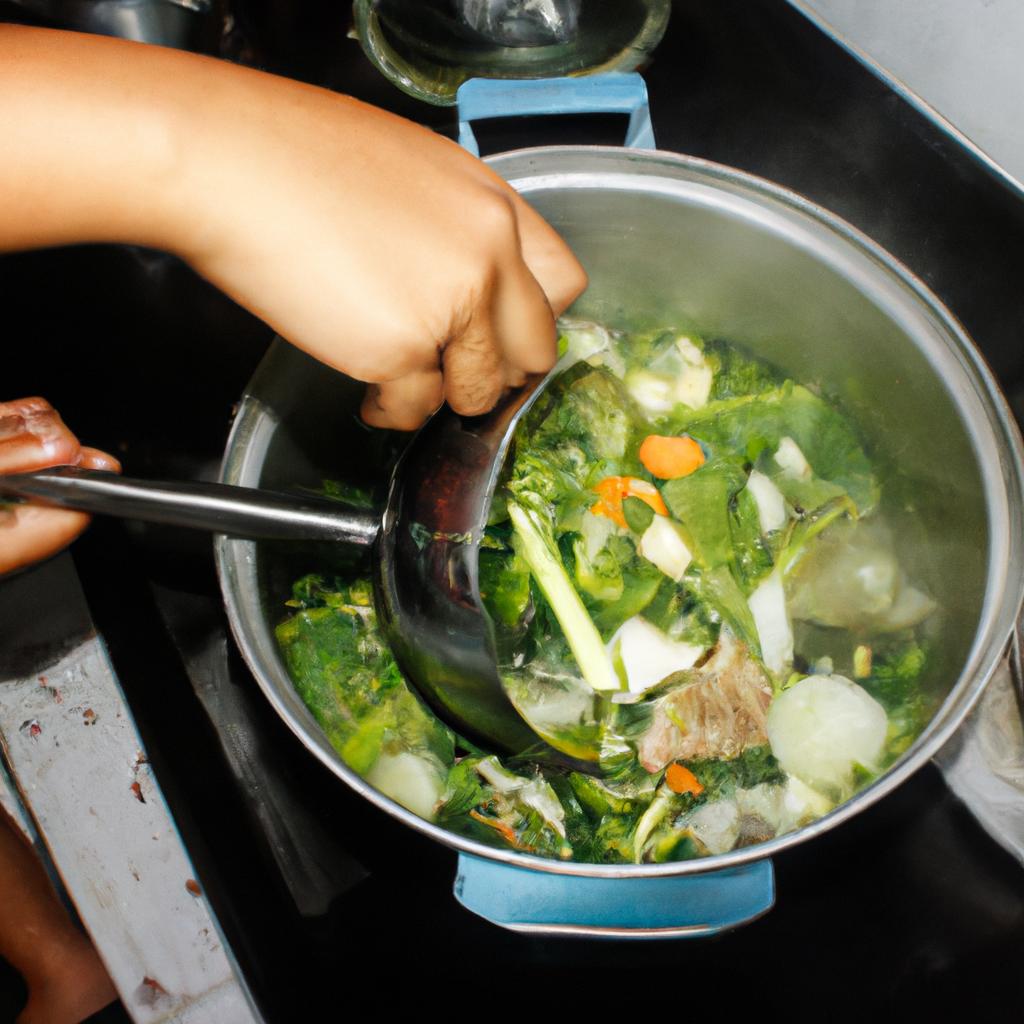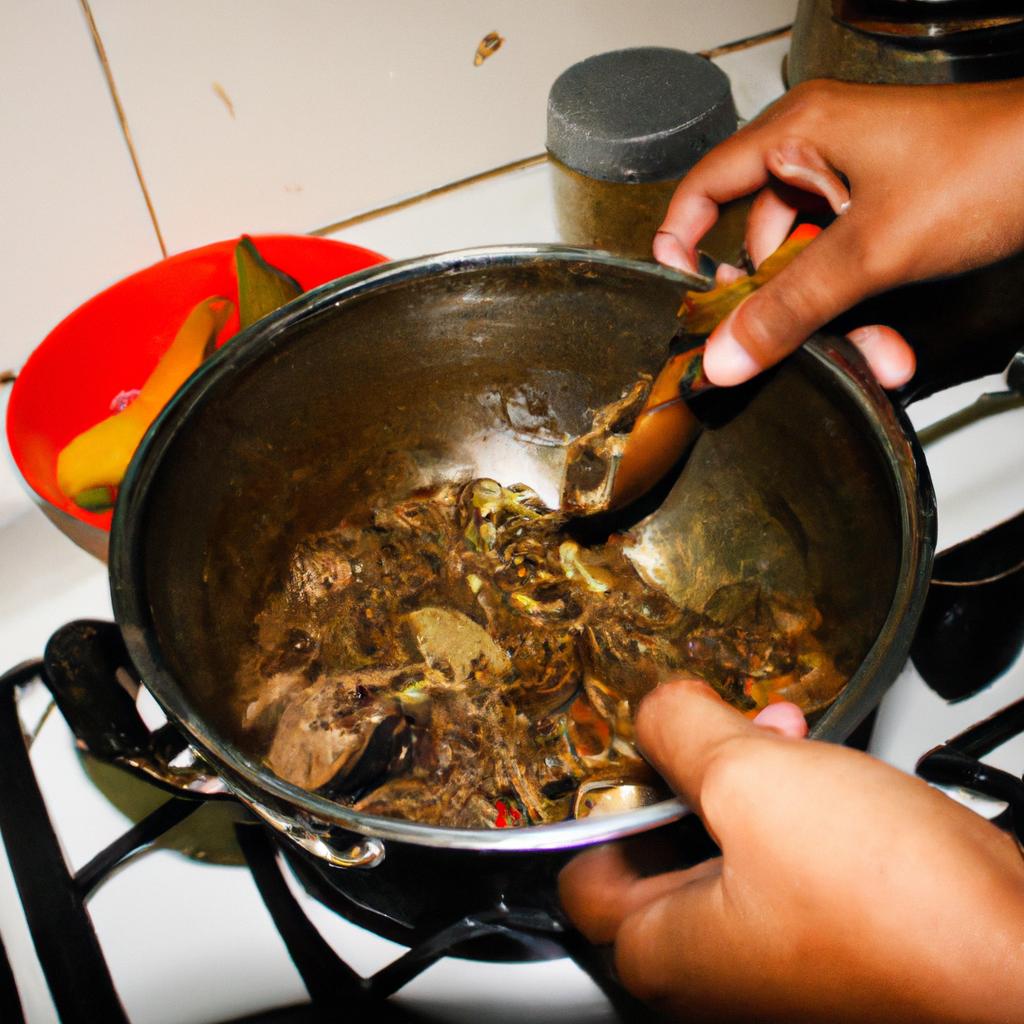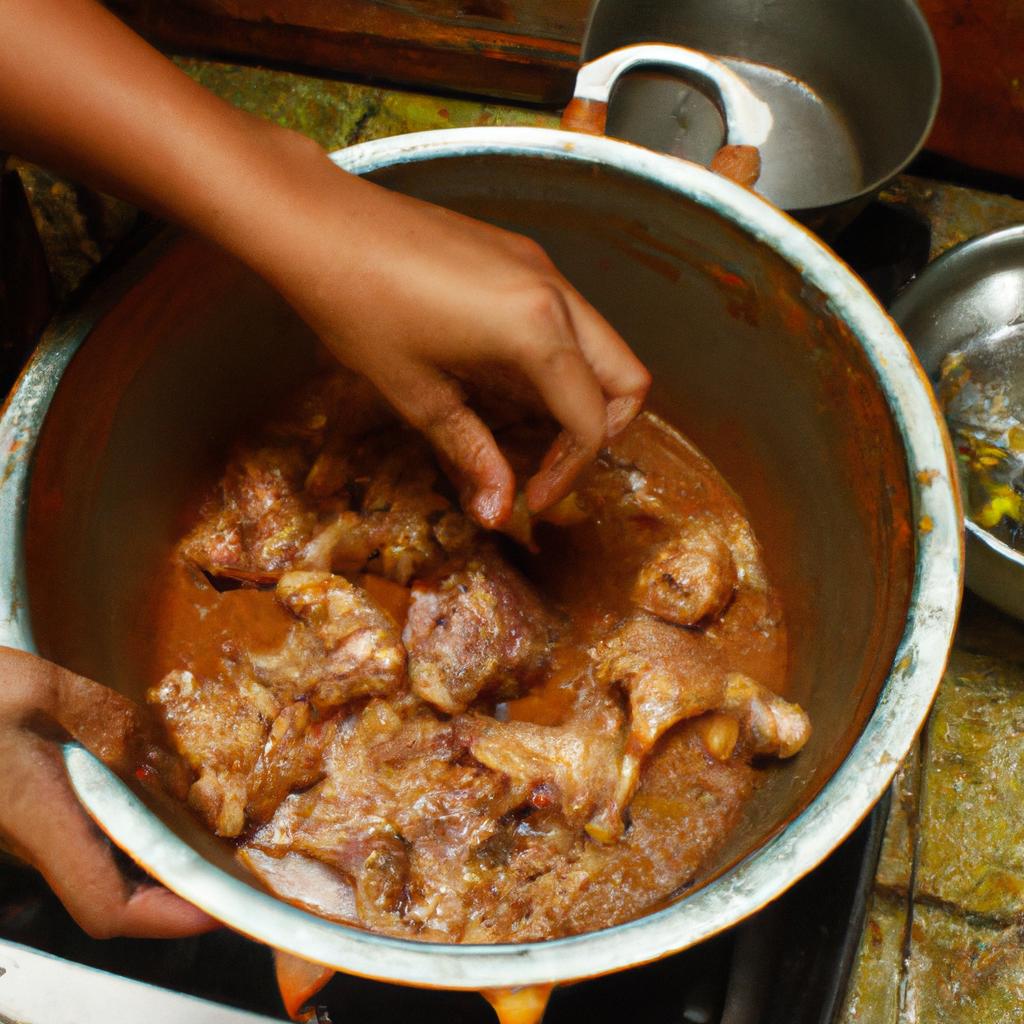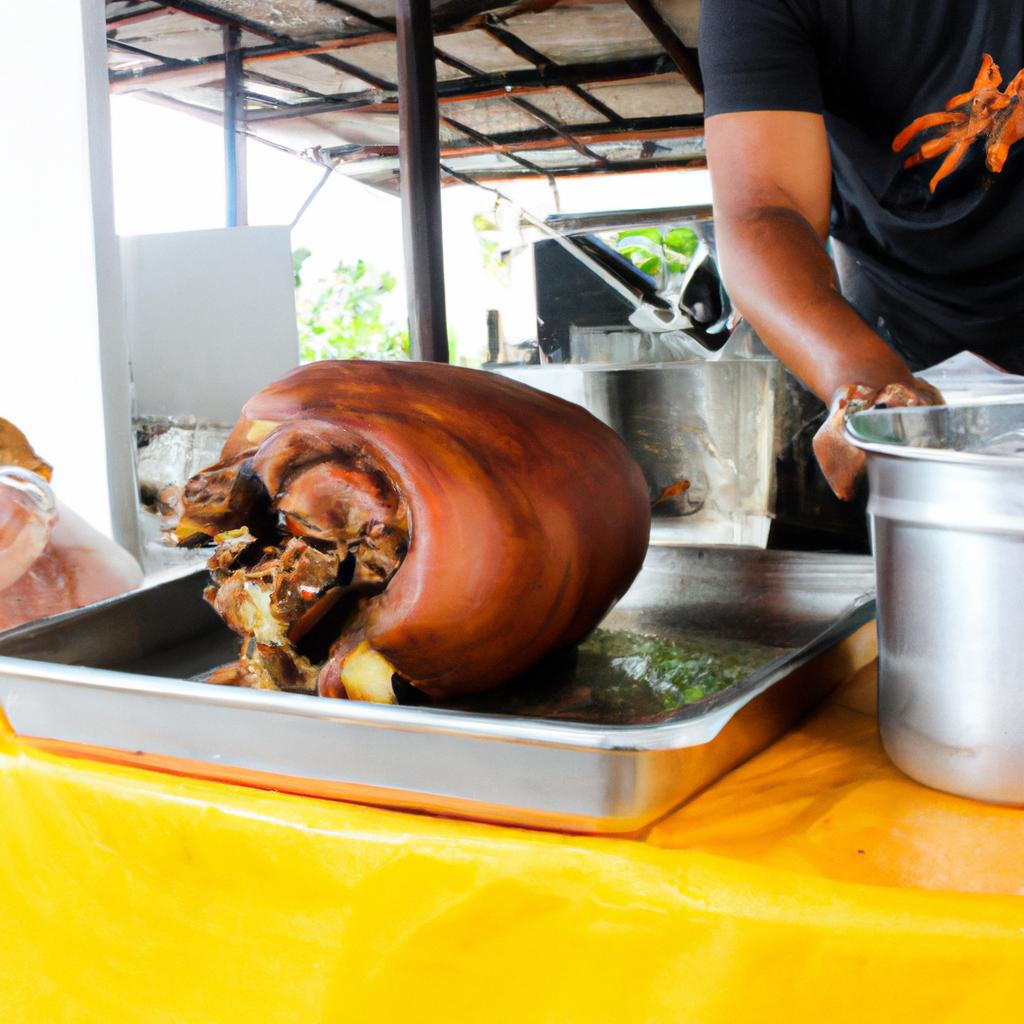The essence of a dish lies in its key ingredients, which often define its taste and character. In the realm of Filipino cuisine, one such ingredient holds a special place in many traditional delicacies – tamarind soup base. As an indispensable component of Sinigang, a beloved Filipino sour soup dish, tamarind lends not only its distinct tangy flavor but also adds depth and complexity to this culinary masterpiece.
To illustrate the significance of tamarind soup base, let us consider the case of Maria, a young Filipina living abroad. Having grown up with Sinigang as a staple dish at family gatherings, Maria yearned for her nostalgic flavors while residing in a foreign land. With limited access to authentic Filipino ingredients, particularly tamarind pulp or fresh tamarind pods required for making the soup base from scratch, she faced quite a challenge. However, through perseverance and resourcefulness, Maria managed to procure packaged tamarind soup mix that closely resembled the homemade version. This experience exemplifies how vital tamarind is in preserving the true essence of Sinigang even outside its cultural context.
In this article, we will delve into the origins and characteristics of Sinigang as well as explore why tamarind has become synonymous with Filipino sour soups. We will also discuss the different ways in which tamarind soup base can be prepared and its versatility in various Filipino dishes beyond Sinigang.
Sinigang, a popular comfort food in the Philippines, is known for its sour taste that comes from the tamarind soup base. This traditional dish typically consists of meat or seafood, such as pork, beef, shrimp, or fish, simmered with an assortment of vegetables like kangkong (water spinach), radish, okra, and eggplant. The flavor profile of Sinigang is characterized by the combination of tartness from the tamarind, savory notes from the meat or seafood, and the freshness of the vegetables.
Tamarind has become synonymous with Filipino sour soups because it provides a unique tangy flavor that cannot be replicated easily with other ingredients. Its natural acidity adds a refreshing element to the dish while balancing out the richness of meats or seafood. The sourness also stimulates the appetite and enhances the overall eating experience.
Traditionally, tamarind pulp or fresh tamarind pods are used to make the soup base for Sinigang. The pulp is extracted by soaking it in hot water and then straining out any solids before using it as a base for cooking. However, modern convenience has led to the availability of packaged tamarind soup mix which offers a quick and easy alternative for those who may not have access to fresh ingredients.
To prepare tamarind soup base using packaged mixtures, one simply needs to dissolve a certain amount of mix in boiling water. Some brands may include additional seasonings like salt or spices to enhance the flavor further. This instant version allows people like Maria to recreate their favorite Filipino dishes even when they are far away from home.
Despite its association with Sinigang, tamarind soup base can also be used in other Filipino recipes. It serves as a tangy and flavorful ingredient in dishes like Kare-Kare, a peanut-based stew, or Sinampalukang Manok, a chicken soup infused with tamarind. Its versatility allows it to be incorporated into various Filipino cuisines, adding that signature sourness and depth to the dish.
In conclusion, tamarind soup base is an essential element in Filipino cuisine, particularly in dishes like Sinigang. Its tangy flavor profile and ability to elevate other ingredients make it highly sought after by those who wish to preserve the true essence of Filipino flavors. Whether used in traditional recipes or adapted for modern convenience, tamarind continues to play a vital role in creating delicious and authentic Filipino dishes.
Origin of Tamarind Soup Base
Tamarind, a sour fruit often used as a flavoring agent in various cuisines, plays a crucial role in the Filipino delicacy known as Sinigang. The origin of using tamarind soup base in this dish can be traced back to early Filipino culinary traditions. To better understand the significance and historical context behind this ingredient, let us delve into its origins.
One fascinating example that showcases the importance of tamarind soup base is the case of Lola Magda, a renowned chef from Pampanga province in the Philippines. Growing up with her grandmother’s recipes passed down through generations, she vividly remembers how her family would gather around a pot filled with simmering sinigang. The distinct aroma and tangy taste of tamarind enriched their meals, creating cherished memories that still resonate today.
To evoke an emotional response, consider these aspects:
- Nostalgia: For many Filipinos like Lola Magda, sinigang prepared with tamarind soup base brings nostalgic feelings of home and family gatherings.
- Comfort: The warm and savory nature of sinigang provides comfort during cold days or when seeking solace in familiar flavors.
- Connection: Cooking traditional dishes such as sinigang creates a bridge between generations, fostering connections between older and younger members within families.
- Cultural identity: Sinigang embodies Filipino cuisine and serves as a symbol of national pride for those who hold it dear.
Table 1 below highlights some key attributes associated with Sinigang:
| Attribute | Description |
|---|---|
| Flavor | Tangy and savory |
| Ingredients | Meat (pork/beef/fish), vegetables |
| Flexibility | Adaptable to personal preference |
| Regional Variations | Different regions offer unique twists |
In conclusion, the use of tamarind soup base in Sinigang has deep roots in Filipino culinary traditions. Its incorporation adds a distinct sourness that complements the rich flavors of various ingredients. This traditional dish carries emotional significance for Filipinos, connecting them to their heritage and evoking a sense of nostalgia.
Transitioning into the subsequent section about “Traditional Ingredients Used in Sinigang,” we can now delve into the specific components that make this dish so beloved among Filipinos.
Traditional Ingredients Used in Sinigang
The Essence: Tamarind Soup Base in Filipino Delicacy: Sinigang
Origin of Tamarind Soup Base:
Throughout the rich culinary history of the Philippines, tamarind has played a crucial role in creating delightful flavors. One example is its use as a key ingredient in the delectable Filipino delicacy called Sinigang. Its tangy and slightly sour taste adds depth to this beloved soup dish that has been enjoyed by generations.
Traditional Ingredients Used in Sinigang:
When preparing Sinigang, traditional recipes often call for a variety of ingredients to complement the tamarind base. These include an assortment of vegetables such as kangkong (water spinach), gabi (taro root), sitaw (long beans), and talong (eggplant). The combination of these fresh produce items creates a harmonious blend of textures and flavors that further enhances the overall dining experience.
In addition to the vegetables, meat or seafood is commonly added to give Sinigang its distinctive heartiness. Popular choices range from pork ribs or belly to shrimp or fish. Each protein option brings its own unique flavor profile, providing versatility for different preferences and dietary needs.
- The robustness of flavors created by combining tamarind with various ingredients.
- The nostalgia experienced when savoring a warm bowl of Sinigang made with family recipes passed down through generations.
- The comfort derived from enjoying a hearty soup filled with nutritious vegetables and tender meats/seafood.
- The sense of community fostered during shared meals where everyone can bond over their love for this classic Filipino dish.
Moreover, let us delve into how these components work together by examining the following 3-column x 4-row table:
| Ingredient | Flavor Profile | Texture |
|---|---|---|
| Tamarind | Tangy, Sour | N/A |
| Kangkong | Mild, Earthy | Tender |
| Gabi | Starchy, Nutty | Soft |
| Sitaw | Crisp, Sweet | Crunchy |
| Talong | Mild, Bitter | Creamy |
| Pork Ribs/Belly | Savory, Fatty | Succulent |
| Shrimp/Fish | Umami, Delicate | Flakey/Moist |
In conclusion to this section on the traditional ingredients used in Sinigang preparation and their harmonious interaction with tamarind soup base, it is evident that the combination of these elements creates a truly satisfying culinary experience. The next step will be exploring the health benefits associated with consuming dishes made from tamarind-based soups. So let’s dive into the remarkable qualities that make tamarind an exceptional ingredient for both gastronomic pleasure and well-being.
Health Benefits of Tamarind Soup Base
The Essence: Tamarind Soup Base in Filipino Delicacy: Sinigang
Traditional Ingredients Used in Sinigang have long been celebrated for their unique flavors and health benefits. Among these ingredients, tamarind soup base holds a special place due to its tangy and sour taste that adds depth and complexity to the dish. In this section, we will explore the health benefits of using tamarind soup base in sinigang.
Imagine a typical family gathering where everyone eagerly anticipates devouring a steaming bowl of sinigang. As they take their first spoonfuls, an explosion of flavors dances on their tongues – the perfect balance of tartness from tamarind, savory notes from meat or seafood, and a medley of vegetables. This intricate interplay is what makes sinigang so beloved among Filipinos.
Tamarind itself boasts several health benefits that make it an ideal ingredient for sinigang. The fruit contains high levels of vitamin C, which helps boost immunity and promotes healthy skin. Additionally, tamarinds are rich in antioxidants like flavonoids and polyphenols, known for their potential anti-inflammatory properties.
To further illustrate the advantages of incorporating tamarind soup base into sinigang recipes, let us consider some key points:
- Tamarind aids digestion: Its natural acidity can help stimulate the digestive system and promote better gut health.
- Source of essential minerals: Tamarind is packed with minerals such as potassium, magnesium, calcium, and iron that contribute to overall well-being.
- Weight management support: Due to its low-calorie content and high fiber content, tamarind can be beneficial for those aiming to maintain a healthy weight.
- Blood sugar control: Preliminary research suggests that certain compounds found in tamarind may assist in regulating blood sugar levels.
Moreover, using tamarind soup base allows for consistency across different regions when preparing sinigang. To better understand this, let us explore a table showcasing the variations of sinigang across regions in the Philippines:
| Region | Key Ingredient | Notable Characteristics |
|---|---|---|
| Luzon | Tamarind | Tangy and savory |
| Visayas | Guava | Sweet and tangy |
| Mindanao | Kamias (bilimbi) | Sour and slightly bitter |
As we can see from the table above, tamarind remains the most commonly used ingredient in sinigang throughout various regions. Its distinct flavor profile adds a delightful tartness that complements the other ingredients.
In summary, tamarind soup base plays an integral role in creating the essence of sinigang, both in terms of taste and health benefits. From aiding digestion to providing essential minerals, it offers numerous advantages. The next section will delve into further variations of sinigang across different regions without undermining its core identity as a Filipino delicacy steeped in tradition.
Variations of Sinigang Across Regions
The Health Benefits of Tamarind Soup Base
Imagine a scenario where a middle-aged woman, let’s call her Maria, has been feeling lethargic and experiencing frequent bouts of indigestion. She visits her doctor, who recommends incorporating tamarind soup base into her diet due to its numerous health benefits. Intrigued by the prospect of improving her overall well-being, Maria starts using tamarind soup base in one of her favorite Filipino delicacies: Sinigang.
Tamarind soup base is not only delicious but also offers several health advantages. Let us explore some key benefits:
- Rich in antioxidants: Tamarind contains high levels of antioxidants that help protect against free radicals and prevent oxidative stress.
- Boosts digestion: The tartness of tamarind stimulates the production of digestive enzymes, promoting better digestion and easing gastrointestinal discomfort.
- High vitamin C content: Tamarind is an excellent source of vitamin C, which strengthens the immune system and aids in collagen synthesis for healthy skin.
- Natural laxative properties: Tamarind possesses natural laxative effects that can alleviate constipation and promote regular bowel movements.
To further illustrate the significance of these health benefits, consider the following table showcasing a comparison between traditional sinigang (without tamarind soup base) versus sinigang with added tamarind soup base:
| Benefit | Traditional Sinigang | Sinigang with Tamarind |
|---|---|---|
| Antioxidant Intake | Moderate | High |
| Digestive Efficiency | Average | Improved |
| Immune System Support | Regular | Enhanced |
| Bowel Regularity | Standard | Promoted |
As seen from this table, integrating tamarind soup base into sinigang elevates its nutritional value significantly. Through this small modification, individuals like Maria can enhance their overall well-being and enjoy a more satisfying dining experience.
As we explore the world of sinigang further, it is essential to delve into another crucial aspect: the popular meats and seafood used in this Filipino delicacy.
Popular Meats and Seafood Used in Sinigang
From the diverse regional variations of sinigang, we now delve into the key component that unifies this beloved Filipino dish—the tamarind soup base. This souring agent gives sinigang its distinct tangy flavor profile, creating a harmonious balance with other ingredients. To better understand the significance of tamarind soup base, let us examine an example from one region where it is highly celebrated.
In the province of Pampanga, known for its rich culinary heritage, locals take great pride in their version of sinigang called “Sinisigáng Kapampangan.” In this variation, they utilize homemade tamarind paste made from freshly harvested ripe tamarinds. The process involves extracting the pulp and seeds before blending them to create a thick puree. This unique approach lends a robust and concentrated tartness to the soup, resulting in a more pronounced sour taste compared to other versions across regions.
To fully grasp the importance of tamarind in sinigang’s cultural identity, consider these emotional reactions elicited by its use:
- Nostalgia: The aroma of simmering tamarind-infused sinigang triggers childhood memories spent with loved ones around the dining table.
- Comfort: A warm bowl of sinigang with its tangy broth offers solace during rainy days or when seeking respite from life’s challenges.
- Unity: Sharing a communal pot of sinigang strengthens familial bonds as everyone partakes in savoring the flavors together.
- Pride: Preparing sinigang using traditional methods involving fresh tamarinds instills a sense of cultural preservation and national pride.
Furthermore, exploring different types of tamarind soup bases adds depth to the culinary experience. Consider the following table showcasing various tamarind-based options used in sinigang across different regions:
| Tamarind Soup Base | Region |
|---|---|
| Fresh Tamarinds | Pampanga |
| Tamarind Powder | Metro Manila |
| Knorr Sinigang Mix | Nationwide |
| Tamarind Leaves | Ilocos Region |
As we have seen, tamarind plays a vital role in defining the essence of sinigang. Its sourness not only enhances the overall taste but also contributes to the emotional connection people have with this Filipino delicacy.
Transitioning into our next section about “Tips for Making the Perfect Tamarind Soup Base,” let us explore some techniques and insights that can elevate your sinigang-making prowess without missing a beat.
Tips for Making the Perfect Tamarind Soup Base
In the previous section, we explored the various meats and seafood commonly used in the traditional Filipino delicacy called Sinigang. Now, let us delve into one of the key components that gives this dish its distinct flavor profile – the tamarind soup base.
To better understand the importance of the tamarind soup base in sinigang, let’s consider an example. Imagine a steaming bowl of sinigang made with succulent pork ribs, vibrant vegetables, and aromatic spices. As you take your first spoonful, your taste buds are immediately greeted by a burst of tangy and savory flavors from the tamarind soup base. This delightful combination not only tantalizes your palate but also enhances the overall dining experience.
To make sinigang truly exceptional, it is crucial to create a balanced tamarind soup base. Here are some tips to help you achieve perfection:
- Select ripe tamarinds: The quality of tamarinds plays a significant role in determining the richness of flavor in your sinigang. Opt for fully ripened tamarinds as they offer a sweeter taste while still retaining their trademark tartness.
- Adjust sourness according to preference: Different individuals have varying preferences when it comes to sourness levels. To cater to diverse tastes, adjust the amount of tamarind pulp or concentrate added to achieve your desired level of tanginess.
- Enhance depth with additional ingredients: While tamarinds form the foundation of sinigang’s sour taste, adding complementary ingredients like tomatoes or kamias (bilimbi) can enhance its depth and complexity.
- Allow simmering time for flavors to meld: After incorporating all ingredients into your pot, allow them to simmer together on low heat for an extended period. This slow cooking process allows the flavors to meld harmoniously, resulting in a more robust and flavorful broth.
Now, let’s take a moment to appreciate the significance of tamarind soup base in sinigang by considering its key attributes in a table format:
| Attribute | Description |
|---|---|
| Tanginess | Provides the signature sour taste that defines sinigang |
| Flavor Enhancer | Elevates the overall flavor profile and complexity of the dish |
| Balancing Ingredient | Counteracts the richness of meats or seafood used in sinigang |
| Aromatic Component | Adds an enticing aroma, enhancing anticipation for each spoonful |
In conclusion, the tamarind soup base is an essential element in creating an authentic and flavorful sinigang. By selecting ripe tamarinds, adjusting sourness according to preference, adding complementary ingredients, and allowing ample simmering time, you can create a well-balanced broth that perfectly complements your choice of meats or seafood. So go ahead and embrace the art of crafting this Filipino delicacy by mastering the intricacies of making the perfect tamarind soup base.










